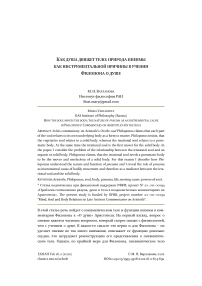Как душа движет тело: природа пневмы как инструментальной причины в учении Филопона о душе
Автор: Варламова Мария Николаевна
Журнал: Schole. Философское антиковедение и классическая традиция @classics-nsu-schole
Рубрика: Статьи
Статья в выпуске: 2 т.16, 2022 года.
Бесплатный доступ
В своем комментарии на О душе Аристотеля Филопон утверждает, что каждая часть души имеет собственное подлежащее. Подлежащим неразумной души он называет пневматическое тело, или пневму – именно с пневмой неразумная душа соотносится как форма с материей, в то время как для органического тела она является первой движущей причиной. В статье мы рассмотрим вопрос о соотношении неразумной души и органического тела, опишем то, как Филопон понимал природу и функции пневмы и покажем, что пневма, будучи инструментальной причиной движения, играет роль посредника или проводника, благодаря которому осуществляется связь между душой и телом.
Аристотель, Филопон, душа, тело, пневма, движущая причина, способности души
Короткий адрес: https://sciup.org/147237657
IDR: 147237657 | DOI: 10.25205/1995-4328-2022-16-2-674-692
Список литературы Как душа движет тело: природа пневмы как инструментальной причины в учении Филопона о душе
- Bernard, W. (1987) “Philoponus on self-awareness,” in R. Sorabji (ed.) Philoponus and the Rejection of Aristotelian Science. London, 154–163.
- Berryman, S. (2002) “Aristotle on Pneuma and Animal Self-Motion,” Oxford Studies in Ancient Philosophy 23, 85–97.
- Blumenthal, H.J (1976) “Neoplatonic elements in the de Anima commentaries,”, Phronesis 21, 64–87.
- Blumenthal, H.J. (1981) “Some Platonist Readings of Aristotle,” Proceedings of the Cambridge Philological Society 27, 1–16.
- Blumenthal, H.J. (1986) “Body and soul in Philoponus,” The Monist 69.3, 370–382.
- Charlton, W. tr., intr., comment. (2005) Philoponus. On Aristotle On the Soul 2.1–6. Duckworth, London.
- Coda, E. (2020) “Common Sense in Themistius and its Reception in the Pseudo-Philoponus and Avicenna,” in D. Benett, J. Toivanen (eds.) Philosophical Problems in Sense Perception: Testing the Limits of Aristotelianism. Springer, 125–151.
- Golitsis, P. (2016) “John Philoponus’ Commentary on the Third Book of Aristotle’s De anima, Wrongly Attributed to Stephanus,” in: R. Sorabji (ed.), Aristotle Re-Interpreted. New Findings on Seven Hundred Years of the Ancient Commentators. London, 393–412.
- Hankinson, R. J. (2006) “Body and soul in Galen”, in King, R. A. H. (ed.), Common to Body and Soul: Philosophical Approaches to Explaining Living Behaviour in Greco-Roman Antiquity. Berlin, 232–258.
- Hayduck, M., ed. (1897) Ioannis Philoponi in Aristotelis De anima libros commentaria. Berlin: Reimer (Commentaria in Aristotelem Graeca, XV).
- Heinze R., ed. (1899) Themistii in libros Aristotelis De Anima Paraphrasis. Berlin: Reimer (Commentaria in Aristotelem Graeca, V.3).
- Kakavelaki A. (2018) “The Notion of Pneuma in the Work of John Philoponus,” Proceedings of the XXIII World Congress of Philosophy 6, 17–21.
- Lautner, P. (1992) “Philoponus, in de Anima III: quest for an author,” Classical Quarterly 42, 510-522.
- Lloyd, G.E.R. (2007) “Pheuma between body and soul,” Journal of the Royal Anthropological Institute, NS 13, supplement 1, 135–146.
- Mittelmann, J. (2013) “Neoplatonic Sailors and Peripatetic Ships: Aristotle, Alexnader and Philoponus,” Journal of the History of Philosophy 51.4, 545–566.
- Ross, W. D., ed. (1956) Aristotelis de Anima. Oxford: Clarendon Press.
- Solmsen, F. (1961) “Greek Philosophy and the Discovery of the Nerves,” Museum Helveticum 18, 169–197.
- Todd, R.B. (1984) “Philosophy and Medicine in John Philoponus' Commentary on Aristotle's De Anima,” Dumbarton Oaks Paper, vol. 38, Symposium on Byzantine Medicine, 103–110.
- Westerink, L.G. (1962) Anonymous Prolegomena to Platonic Philosophy. Amsterdam, 1962.
- Afonasin, E.V., transl. (2016) «Aristotel’ o dvizhenii zhivotnykh [Aristotle on the movement of animals]», ΣΧΟΛΗ (Schole) 10.2, 733–753 (in Russian).
- Афонасин, Е.В., пер., прим. (2016) «Аристотель о движении животных», ΣΧΟΛΗ (Schole) 10.2, 733–753.


